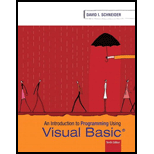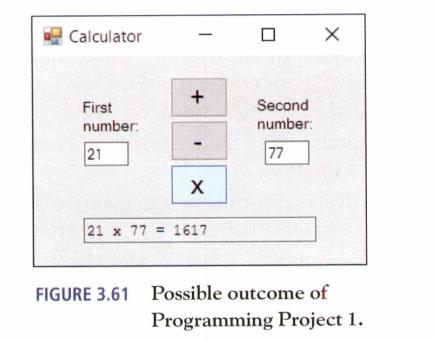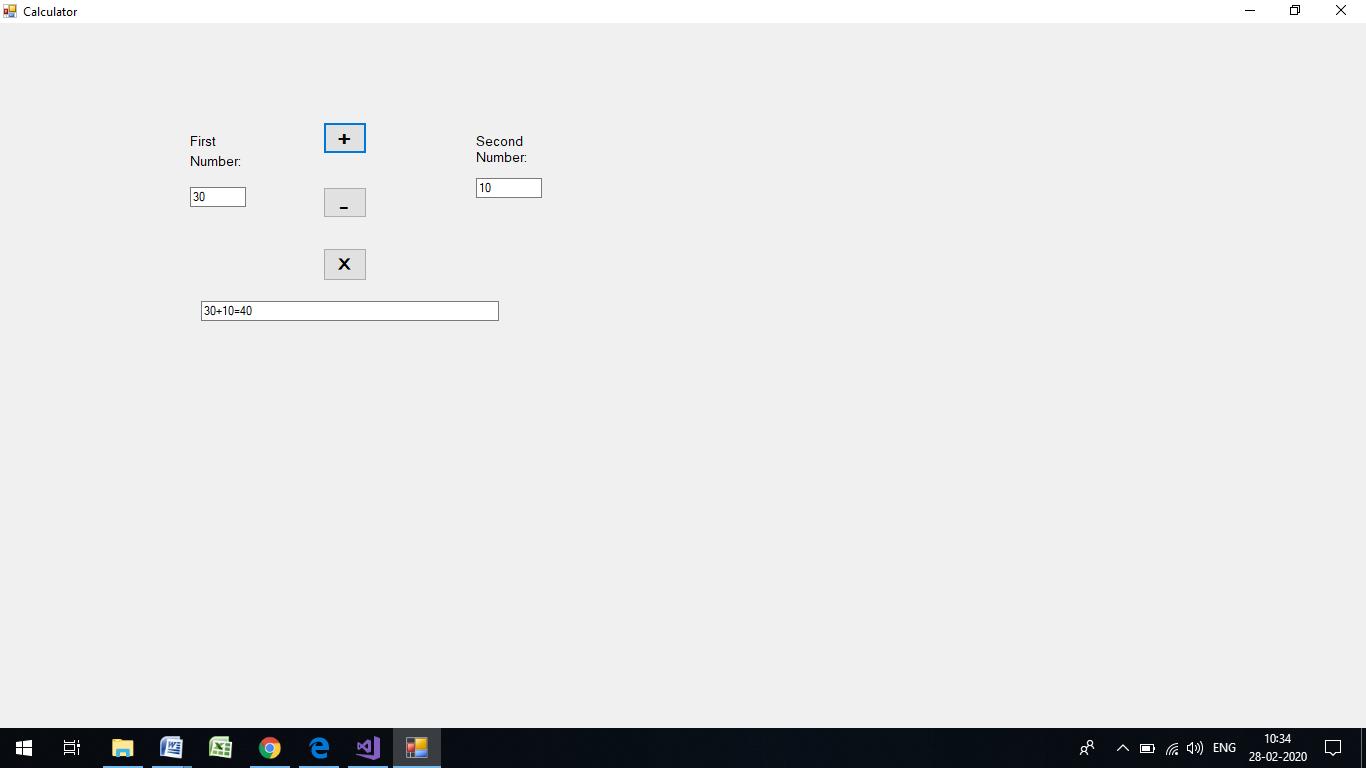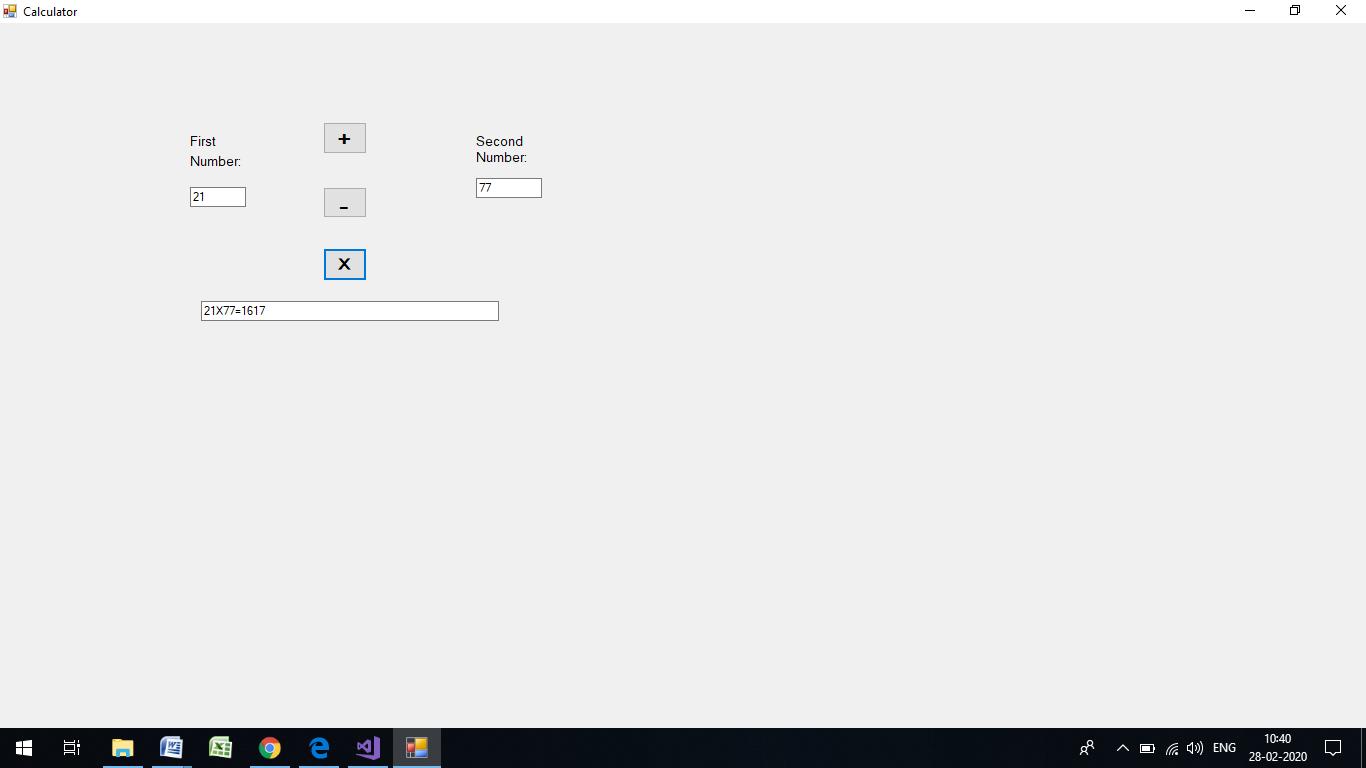
Concept explainers
Calculator Write a

Implementation of a program to create a calculator which performs addition, subtraction, and multiplication.
Program Plan:
Write a program which creates a calculator having two input text boxes in which the numbers are entered by the user.
The user can click on any of the three buttons of addition, subtraction, and multiplication.
Whichever button is clicked, it’s result will be calculated and displayed on the output textbox.
Program Description:
The program works for the creation of a calculator which adds, subtracts, or multiplies the two numbers entered by the user in two separate textboxes and displays the calculation in the output textbox.
There are two textboxes which take input from the user for the first number and the second number.
Three buttons, one for addition, second for subtraction, and the third for multiplication are created.
On clicking the respective buttons, the output textbox will display the calculation.
Explanation of Solution
Program:
Public Class Calculator
'Declare variable.
Dim var2 As Integer
'Declare variable.
Dim var1 As Integer
'Declare variable.
Dim result As Integer
'Create the event for the textbox.
Private Sub TextBox1_TextChanged(sender As Object, e As EventArgs) Handles TextBox1.TextChanged
'Assign value
var1 = TextBox1.Text
'Assign text to the textbox.
TextBox3.Text = var1
'Ending the function
End Sub
'Create text box event.
Private Sub TextBox2_TextChanged(sender As Object, e As EventArgs) Handles TextBox2.TextChanged
'Assign text to the textbox.
var2 = TextBox2.Text
End Sub
'Create a button click event
Private Sub Button1_Click(sender As Object, e As EventArgs) Handles Button1.Click
result = var1 + var2
'Assign text to the textbox.
TextBox3.Text = var1 & "+" & var2 & "=" & result
End Sub
'Create a button click evetn
Private Sub Button2_Click(sender As Object, e As EventArgs) Handles Button2.Click
result = var1 - var2
'Assign text to the textbox.
TextBox3.Text = var1 & "-" & var2 & "=" & result
End Sub
'Create a button click event
Private Sub Button3_Click(sender As Object, e As EventArgs) Handles Button3.Click
result = var1 * var2
'Assign text to the textbox.
TextBox3.Text = var1 & "*" & var2 & "=" & result
End Sub
End Class
On pressing the addition button:

On pressing the subtraction button:

On pressing the multiplication button:

Want to see more full solutions like this?
Chapter 3 Solutions
Introduction to Programming Using Visual Basic (10th Edition)
Additional Engineering Textbook Solutions
INTERNATIONAL EDITION---Engineering Mechanics: Statics, 14th edition (SI unit)
Thinking Like an Engineer: An Active Learning Approach (4th Edition)
Starting Out with Python (4th Edition)
Database Concepts (8th Edition)
Degarmo's Materials And Processes In Manufacturing
Electric Circuits. (11th Edition)
- "Do not use AI tools. Solve the problem by hand on paper only and upload a photo of your handwritten solution."arrow_forward"Do not use AI tools. Solve the problem by hand on paper only and upload a photo of your handwritten solution."arrow_forward"Do not use AI tools. Solve the problem by hand on paper only and upload a photo of your handwritten solution."arrow_forward
- "Do not use AI tools. Solve the problem by hand on paper only and upload a photo of your handwritten solution."arrow_forwardSolve this "Do not use AI tools. Solve the problem by hand on paper only and upload a photo of your handwritten solution."arrow_forward"Do not use AI tools. Solve the problem by hand on paper only and upload a photo of your handwritten solution."arrow_forward
- "Do not use AI tools. Solve the problem by hand on paper only and upload a photo of your handwritten solution."arrow_forwardSpecifications: Part-1Part-1: DescriptionIn this part of the lab you will build a single operation ALU. This ALU will implement a bitwise left rotation. Forthis lab assignment you are not allowed to use Digital's Arithmetic components.IF YOU ARE FOUND USING THEM, YOU WILL RECEIVE A ZERO FOR LAB2!The ALU you will be implementing consists of two 4-bit inputs (named inA and inB) and one 4-bit output (named out). Your ALU must rotate the bits in inA by the amount given by inB (i.e. 0-15).Part-1: User InterfaceYou are provided an interface file lab2_part1.dig; start Part-1 from this file.NOTE: You are not permitted to edit the content inside the dotted lines rectangle. Part-1: ExampleIn the figure above, the input values that we have selected to test are inA = {inA_3, inA_2, inA_1, inA_0} = {0, 1, 0,0} and inB = {inB_3, inB_2, inB_1, inB_0} = {0, 0, 1, 0}. Therefore, we must rotate the bus 0100 bitwise left by00102, or 2 in base 10, to get {0, 0, 0, 1}. Please note that a rotation left is…arrow_forwardSolve this "Do not use AI tools. Solve the problem by hand on paper only and upload a photo of your handwritten solution."arrow_forward
- Solve this "Do not use AI tools. Solve the problem by hand on paper only and upload a photo of your handwritten solution."arrow_forward"Do not use AI tools. Solve the problem by hand on paper only and upload a photo of your handwritten solution."arrow_forwardSolve this "Do not use AI tools. Solve the problem by hand on paper only and upload a photo of your handwritten solution."arrow_forward
 C++ for Engineers and ScientistsComputer ScienceISBN:9781133187844Author:Bronson, Gary J.Publisher:Course Technology Ptr
C++ for Engineers and ScientistsComputer ScienceISBN:9781133187844Author:Bronson, Gary J.Publisher:Course Technology Ptr Microsoft Visual C#Computer ScienceISBN:9781337102100Author:Joyce, Farrell.Publisher:Cengage Learning,
Microsoft Visual C#Computer ScienceISBN:9781337102100Author:Joyce, Farrell.Publisher:Cengage Learning, C++ Programming: From Problem Analysis to Program...Computer ScienceISBN:9781337102087Author:D. S. MalikPublisher:Cengage Learning
C++ Programming: From Problem Analysis to Program...Computer ScienceISBN:9781337102087Author:D. S. MalikPublisher:Cengage Learning- Programming Logic & Design ComprehensiveComputer ScienceISBN:9781337669405Author:FARRELLPublisher:Cengage
 Programming with Microsoft Visual Basic 2017Computer ScienceISBN:9781337102124Author:Diane ZakPublisher:Cengage Learning
Programming with Microsoft Visual Basic 2017Computer ScienceISBN:9781337102124Author:Diane ZakPublisher:Cengage Learning EBK JAVA PROGRAMMINGComputer ScienceISBN:9781337671385Author:FARRELLPublisher:CENGAGE LEARNING - CONSIGNMENT
EBK JAVA PROGRAMMINGComputer ScienceISBN:9781337671385Author:FARRELLPublisher:CENGAGE LEARNING - CONSIGNMENT





